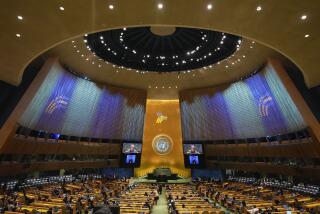Bridges, but Still Potholes, on Way to Religious Freedom Worldwide
- Share via
The historic first meeting of many of the world’s religious and spiritual leaders at the United Nations Aug. 28-31 made clear both the promise and the challenges to interfaith cooperation in the century ahead.
Over 1,000 high-ranking religionists listened to prayers, music and speeches, and took part in seminars dealing with religion’s role in promoting peace, eradicating poverty and halting environmental degradation. They concluded their deliberations by signing a document, “A Commitment to Tolerance and Non-Violence.”
In it, the leaders pledged to collaborate with the U.N.’s peacemaking efforts, condemn all violence in the name of religion, seek mutual forgiveness and reconciliation between religious and ethnic groups, promote a more equitable distribution of wealth between and among nations, and seek the abolition of nuclear weapons.
I was privileged to be an official observer at the U.N. Millennium Peace Summit of Religious and Spiritual Leaders, and was joined by two distinguished religious leaders from Orange County, Muzammil Siddiqi, president both of the Islamic Society of Orange County and of North America, and Ananda Guruge, vice president of the World Fellowship of Buddhists and academic dean of Hsi Lai University in Rosemead.
The summit was the culmination of a year of important interfaith meetings. It began last December with the Parliament of the World’s Religions in Cape Town, South Africa, where 7,000 religious leaders, activists and scholars held hundreds of seminars exploring every aspect of interfaith dialogue and cooperation.
It continued in June with the signing in Pittsburgh of the charter of the United Religions Initiative, whose aim is “to promote enduring, daily interfaith cooperation, to end religiously motivated violence and to create cultures of peace, justice and healing for the Earth and all living beings.”
Then in July, on Cal State Fullerton’s campus, the North American Interfaith Network, an umbrella organization of virtually all interreligious groups in the U.S. and Canada (with some representation from Mexico), held its annual meeting to coordinate and promote the goals of the interfaith movement.
Finally, today, the Rev. Robert Schuller is hosting Ahmad Kuftaro, grand mufti of Syria, at morning services in the Crystal Cathedral, where they will discuss peace and understanding between Christians and Muslims.
It is clear that century 21 will be the era of interfaith dialogue and cooperation and that it holds out the prospect of a more just, peaceful and ecologically healthy world. However, the obstacles to such a vision are substantial and were apparent at the U.N. summit. Two in particular stood out at the summit.
The first is conversionism--the mandate in some religious traditions, most notably in some elements of Christianity but also a factor in Islam, to actively seek proselytes. During the U.N. summit, there were a few impassioned speeches by indigenous religious leaders calling for an end to missionary activity.
Wande Abimbola, a Yoruba (African) priest, implored the gathering to “Leave us alone to worship the gods of our ancestors.” Similarly, Chief Oren Lyons, faithkeeper of the Onondaga Nation (Iroquois Confederacy), declared, “We are the people who have survived your proselytizing.”
By contrast, Francis Cardinal Arinze, head of the Pontifical Council for Interreligious Dialogue, noted the U.N. Charter’s guarantee of the right to non-coercively promote one’s religion, and stated that religion should be able to feed the poor even when it leads to conversion. The hopeful development here is the growing recognition that old ways of making converts--through economic, political, or even physical coercion--are unacceptable.
The second obstacle to interfaith work is nationalism, a truth brought home by the absence of perhaps the world’s most famous interfaith activist: the Dalai Lama. China objected to his participation because he represents the Tibetan government-in-exile, which the U.N.--and, of course, China itself--does not recognize. (A number of summit speakers denounced the decision to bar the Dalai Lama and received vigorous applause from the delegates.)
On the other side, Bishop Fu Tieshen of the Chinese Catholic Conference, a state-authorized church not affiliated with the Vatican, stated that this is a “golden age for religion in China.” It is hard to imagine a more blatant example of religion in the service of the state than the bishop’s. Yet, in a number of states, loyalty to one’s religion and one’s country are intimately intertwined, so that the task of promoting religious freedom and tolerance for minority faiths is daunting.
Despite these and other challenges, the momentum for interfaith work is building and could help make century 21 far more just and peaceful than the 20th.
More to Read
Sign up for Essential California
The most important California stories and recommendations in your inbox every morning.
You may occasionally receive promotional content from the Los Angeles Times.













